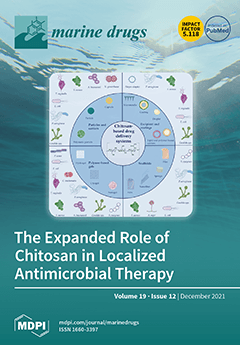Four new triterpene disulfated glycosides, chitonoidosides E
1 (
1), F (
2), G (
3), and H (
4), were isolated from the Far-Eastern sea cucumber
Psolus chitonoides and collected near Bering Island (Commander Islands) at depths of
[...] Read more.
Four new triterpene disulfated glycosides, chitonoidosides E
1 (
1), F (
2), G (
3), and H (
4), were isolated from the Far-Eastern sea cucumber
Psolus chitonoides and collected near Bering Island (Commander Islands) at depths of 100–150 m. Among them there are two hexaosides (
1 and
3), differing from each other by the terminal (sixth) sugar residue, one pentaoside (
4) and one tetraoside (
2), characterized by a glycoside architecture of oligosaccharide chains with shortened bottom semi-chains, which is uncommon for sea cucumbers. Some additional distinctive structural features inherent in
1–
4 were also found: the aglycone of a recently discovered new type, with 18(20)-ether bond and lacking a lactone in chitonoidoside G (
3), glycoside 3-
O-methylxylose residue in chitonoidoside E
1 (
1), which is rarely detected in sea cucumbers, and sulfated by uncommon position 4 terminal 3-
O-methylglucose in chitonoidosides F (
2) and H (
4). The hemolytic activities of compounds
1–
4 and chitonoidoside E against human erythrocytes and their cytotoxic action against the human cancer cell lines, adenocarcinoma HeLa, colorectal adenocarcinoma DLD-1, and monocytes THP-1, were studied. The glycoside with hexasaccharide chains (
1,
3 and chitonoidoside E) were the most active against erythrocytes. A similar tendency was observed for the cytotoxicity against adenocarcinoma HeLa cells, but the demonstrated effects were moderate. The monocyte THP-1 cell line and erythrocytes were comparably sensitive to the action of the glycosides, but the activity of chitonoidosides E and E
1 (
1) significantly differed from that of
3 in relation to THP-1 cells. A tetraoside with a shortened bottom semi-chain, chitonoidoside F (
2), displayed the weakest membranolytic effect in the series.
Full article






